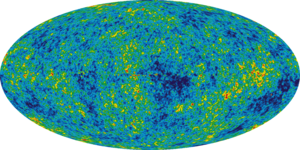Big Crunch
| Physical cosmology |
 |
Universe · Big Bang
Age of the Universe
Timeline of the Big Bang
Ultimate fate of the universe
| Structure Formation |
Shape of the universe
Structure formation
Galaxy formation
Large-scale structure
Galaxy filaments |
| Timeline |
Timeline of cosmological theories
Timeline of the Big Bang
Future of an expanding universe |
| Experiments |
Observational cosmology
2dF · SDSS
COBE · BOOMERanG · WMAP |
|
|
In physical cosmology, the Big Crunch is one possible scenario for the ultimate fate of the universe, in which the metric expansion of space eventually reverses and the universe recollapses, ultimately ending as a black hole singularity.
Overview
If the gravitational attraction of all the matter within the observable horizon is high enough, the expansion of the universe eventually reverses. In the absence of a cosmological constant, this happens when the matter density exceeds the critical density. Because entropy continues to increase in the contracting phase, the contraction looks very different from the time reversal of the expansion. While the early universe was highly uniform, a contracting universe would become increasingly clumped. Eventually all matter would collapse into black holes, which would then coalesce with each other; the unified black hole singularity is the Big Crunch singularity.
Recent experimental evidence (namely the observation of distant supernovae as standard candles, and the well-resolved mapping of the cosmic microwave background) have shown that the expansion of the universe is not being slowed down by gravity but rather accelerating. However, since the nature of the dark energy that drives the acceleration is unknown, it is still possible that it might eventually reverse sign and cause a rapid collapse.[1]
See also
- Big Bounce
- Big Rip
- Heat death of the universe
- Oscillatory universe
- Cyclic model
- Ultimate fate of the universe
- Arrow of time
- Entropy (arrow of time)
References
- ↑ Y Wang, J M Kratochvil, A Linde, and M Shmakova, Current Observational Constraints on Cosmic Doomsday. JCAP 0412 (2004) 006, astro-ph/0409264
External links
